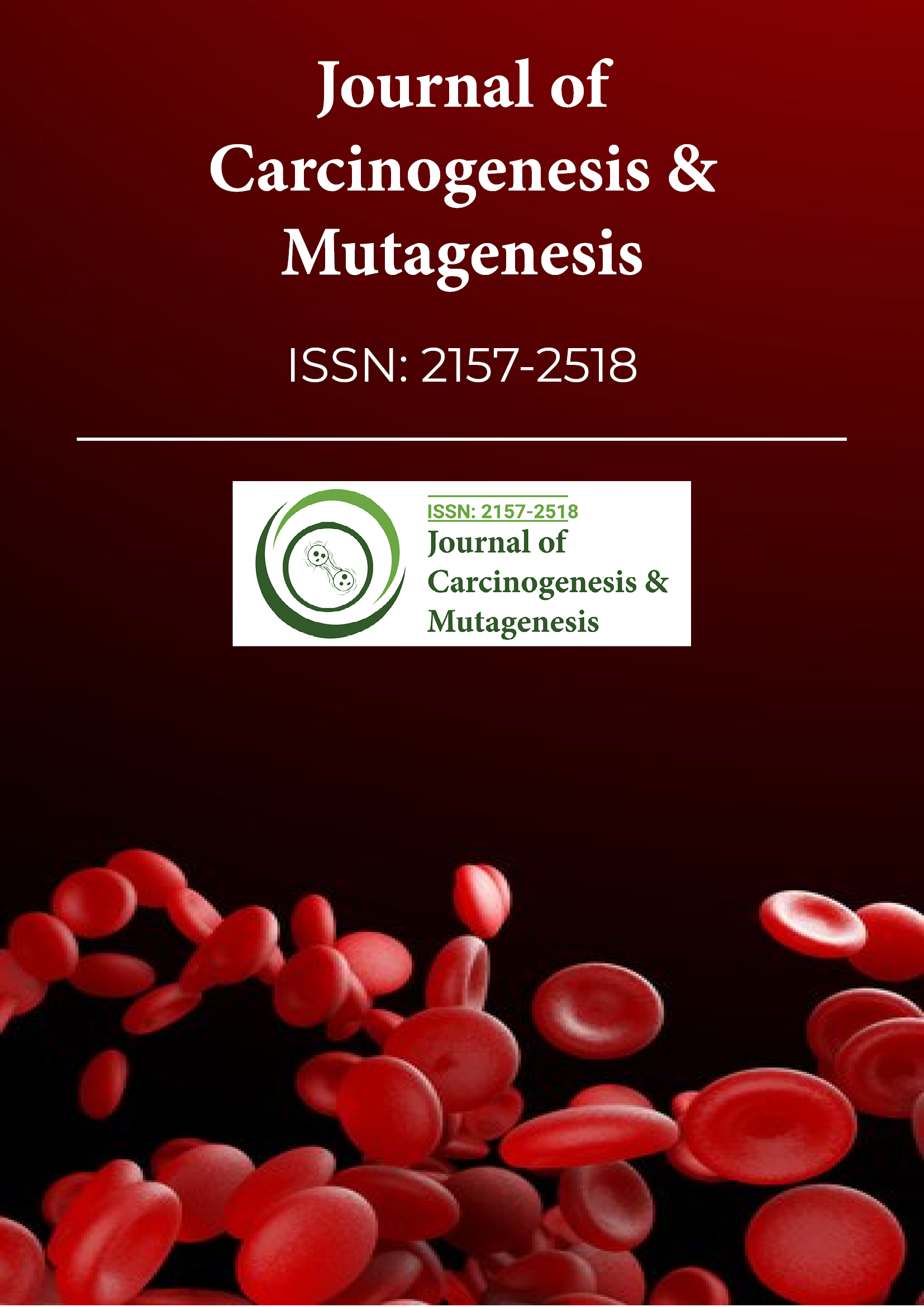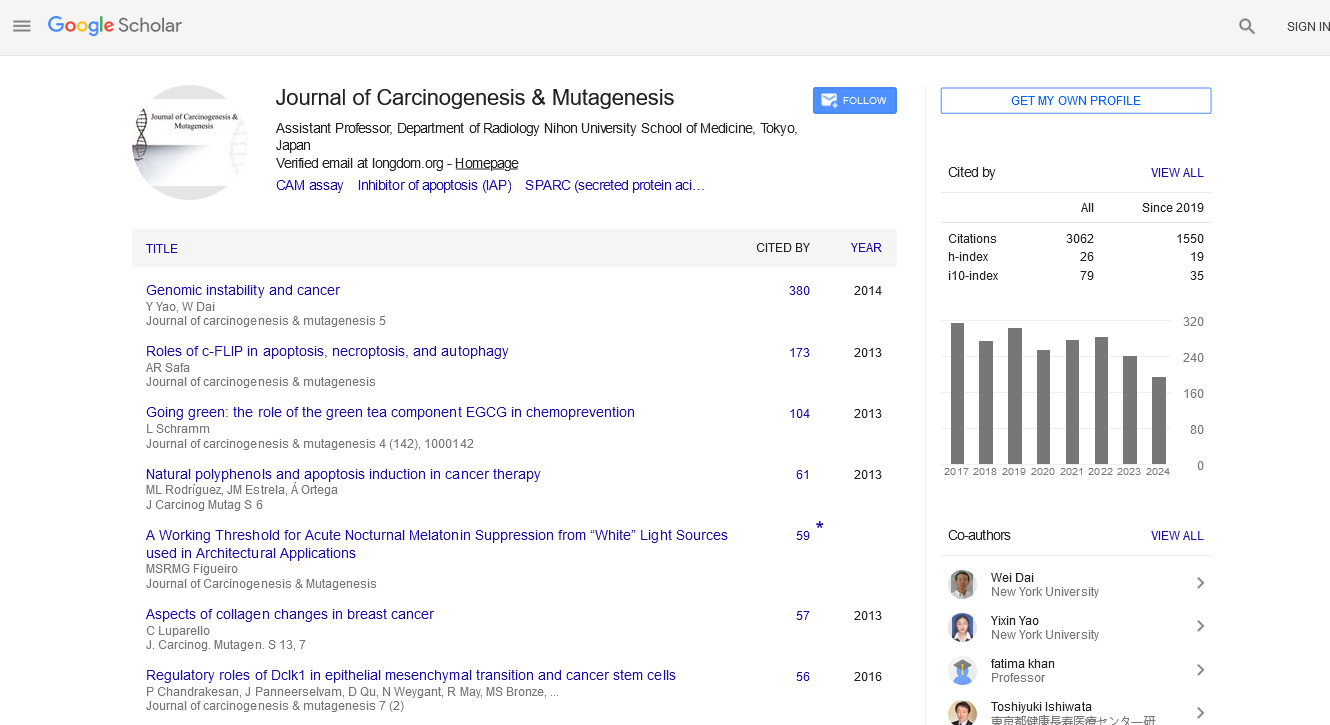Indexed In
- Open J Gate
- Genamics JournalSeek
- JournalTOCs
- Ulrich's Periodicals Directory
- RefSeek
- Hamdard University
- EBSCO A-Z
- OCLC- WorldCat
- Publons
- Geneva Foundation for Medical Education and Research
- Euro Pub
- Google Scholar
Useful Links
Share This Page
Journal Flyer

Open Access Journals
- Agri and Aquaculture
- Biochemistry
- Bioinformatics & Systems Biology
- Business & Management
- Chemistry
- Clinical Sciences
- Engineering
- Food & Nutrition
- General Science
- Genetics & Molecular Biology
- Immunology & Microbiology
- Medical Sciences
- Neuroscience & Psychology
- Nursing & Health Care
- Pharmaceutical Sciences
Perspective - (2025) Volume 16, Issue 3
The Impact of Chromosomal DNA on Oncogenesis and Mutation
Faraz Bishehsari*Received: 31-May-2025, Manuscript No. JCM-25-29464; Editor assigned: 02-Jun-2025, Pre QC No. JCM-25-29464 (PQ); Reviewed: 16-Jun-2025, QC No. JCM-25-29464; Revised: 23-Jun-2025, Manuscript No. JCM-25-29464 (R); Published: 30-Jun-2025, DOI: 10.35248/2157-2518.25.16.479
Abstract
Description
Chromosomal DNA, the hereditary material found in the nucleus of eukaryotic cells, is fundamental to the functioning and reproduction of life. It contains the instructions that direct all cellular processes, including growth, division, and programmed cell death. In humans, chromosomal DNA is organized into 23 pairs of chromosomes, each composed of a long, linear molecule of DNA tightly coiled around histone proteins. This packaging forms a compact structure known as chromatin, which ensures efficient DNA storage and regulation.
Each chromosome contains thousands of genes, which are specific sequences of nucleotides that encode proteins and functional RNA molecules. These genes are responsible for determining the characteristics of an organism and maintaining cellular operations. The ends of chromosomes, called telomeres, consist of repetitive nucleotide sequences that protect the chromosome from deterioration and unwanted fusion with neighboring chromosomes. Telomere length gradually shortens with each cell division, and critically short telomeres can lead to cell senescence or apoptosis. In cancer cells, the enzyme telomerase is often activated, enabling these cells to maintain telomere length and divide indefinitely.
The accurate replication of chromosomal DNA is vital to ensure genetic stability. During the S phase of the cell cycle, DNA is duplicated with the help of various enzymes and replication complexes. Despite the high fidelity of this process, errors can occasionally occur. To counteract this, cells are equipped with several DNA repair mechanisms such as base excision repair, nucleotide excision repair, mismatch repair, and homologous recombination. These systems detect and correct damage caused by replication errors or external factors like radiation and chemical exposure.
When DNA repair mechanisms fail or become defective, mutations can accumulate within the genome. These mutations can take many forms, including base substitutions, deletions, insertions, or large chromosomal rearrangements. Such genetic alterations can disrupt the function of important regulatory genes and lead to carcinogenesis. In cancer, mutations often activate oncogenes— genes that promote uncontrolled cell proliferation—or inactivate tumor suppressor genes, which normally function to suppress tumor growth and initiate cell death in response to DNA damage. Chromosomal instability is a hallmark of cancer and often manifests as changes in chromosome number (aneuploidy), structural abnormalities (translocations, deletions, amplifications), and loss of heterozygosity. One well-known example is the Philadelphia chromosome, which results from a translocation between chromosomes 9 and 22. This rearrangement leads to the creation of the BCR-ABL fusion gene, which encodes a constitutively active tyrosine kinase that drives the development of chronic myeloid leukemia.
Mutagenesis, the process by which genetic mutations are generated, can occur spontaneously or be induced by environmental agents known as mutagens. Physical agents like ultraviolet and ionizing radiation, as well as chemical compounds such as alkylating agents or polycyclic aromatic hydrocarbons, can cause breaks or alterations in DNA structure. If these lesions are not correctly repaired, they may result in permanent mutations in the DNA sequence, increasing the risk of cancer development.
In conclusion chromosomal DNA’s stability is constantly challenged by both internal and external factors. While cells possess sophisticated mechanisms to preserve genomic integrity, persistent damage or failure in repair pathways can lead to the initiation and progression of cancer. The study of chromosomal DNA and its alterations has become a central focus in cancer biology, providing insights into mechanisms of tumor development and offering targets for therapeutic intervention. Continued exploration of chromosomal dynamics will be essential for improving cancer diagnosis, predicting disease progression, and designing effective treatments.
Citation: Bishehsari F. (2025). The Impact of Chromosomal DNA on Oncogenesis and Mutation. J Carcinog Mutagen. 16:479
Copyright: © 2025 Bishehsari F. This is an open-access article distributed under the terms of the Creative Commons Attribution License, which permits unrestricted use, distribution, and reproduction in any medium, provided the original author and source are credited.


